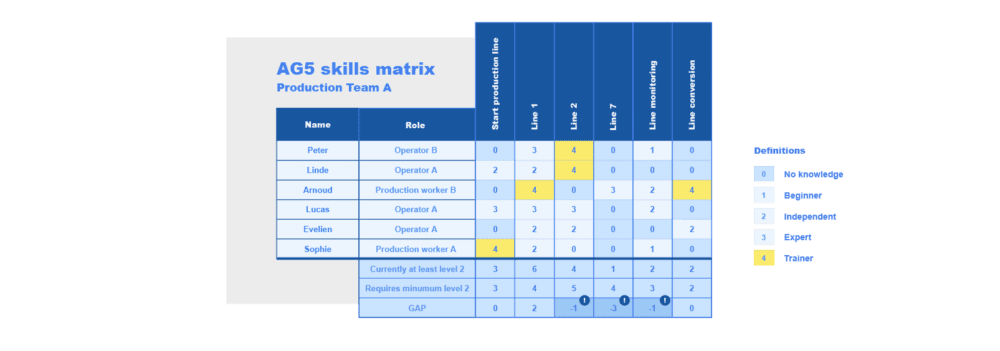Everything you need to know about workforce management
In this article we cover all aspects of workforce management, from planning to performance optimization, providing essential insights for effective organizational management.

Efficiency involves assigning the right people to the right jobs at the right time. To do this optimally, you’d do well to consider workforce management.
Read what workforce management is, how it can benefit you, and which tools can help you put it into practice.
What is workforce management?Copied
Workforce management addresses how you match your workloads to staffing levels and vice versa. It involves always assigning the right people to the right jobs at the right time. But how? By forecasting workloads, planning staffing levels, and generating corresponding work/shift rosters.
Workforce management provides greater clarity for everyone involved in production or processing:
- Clients can keep up to date with current progress so they can respond accordingly.
- Contractors can adjust staffing levels to match workloads.
- Staff know where, when, and how they’re needed to work – creating a better work-life balance.
- Customers receive better service regardless of the communications channel they select.
But can workforce management benefit you?Copied
Actively using workforce management offers your organization numerous benefits. Below, we’ll discuss some of the foremost advantages.
1. Gives you a strategic competitive advantage
Workforce management helps you respond more adequately to the latest trends and developments and plan for the longer term. It then becomes much easier to optimize inflow and outflow percentages, find a balance between permanent employees and flex workers, and manage your labor pool.
2. Bridges the divide between strategy and labor market
By integrating workforce management into your operational strategy, you’ll be able to respond more easily to technological innovation, labor market changes, and ever-changing customer requirements. After all, it’s these variables that affect your organizational strategy and workforce. Workforce management allows you to anticipate a variety of scenarios.
3. Creates a more flexible workforce
Experts believe that a flexible workforce will play an increasingly vital role in businesses’ future success. Looking to ramp up or ramp down more efficiently in response to current requirements or market developments? Want to be more proactive about the key skills and competences needed in the future? Need to improve workforce productivity with flex pools and or multidisciplinary, self-managing teams? Then look no further than workforce management!
4. Helps you learn from the past and present
Workforce management allows you to retrieve and analyze information – past and present – and to use this to predict future staffing level requirements. Sources include reports, old forecasts, or real-time data. For example, if you spot that actual progress is deviating from planned progress, then you can respond quickly and make appropriate adjustments. Because workforce management relies on hard data rather than intuition, it helps you make well-founded decisions.

What elements make up workforce management?Copied
Workforce management is a process made up of four main elements:
1. Forecasting
Forecasting involves predicting future developments and challenges based on historical information. You can analyze and interpret existing data to forecast future workloads – weekly, daily, or even hourly. Armed with this information, you can then determine the staffing levels you’ll need. Forecasting also involves examining your customers’ requirements.
2. Capacity management
Capacity management involves working out how many FTEs and flex workers you’ll need to complete the estimated work on time. In other words, you match workload to workforce, for example with budget cycles and targeted pool management. You should also take into account time for toolbox meetings, absenteeism, vacations, and ad hoc projects. All these factors can affect workloads and staffing levels.
3. Scheduling
Scheduling is the direct result of capacity management. The aim is to create a clear work schedule putting the right people in the right place at the right time. You do this by translating the number of employees required to the number of scheduled activities for each employee. Naturally, you’ll also have to take into account each employee’s skills and competences. Scheduling your staff’s time as optimally as possible helps boost efficiency and employee satisfaction levels.
4. Traffic management
The last element revolves around fine-tuning supply and demand. If discrepancies start to emerge due to changing staff availability or staffing levels, then you’ll be able to respond more rapidly and prevent delays, by restoring the balance between demand and availability of resources.
Workforce management toolsCopied
Workforce management is a lot easier when you have the right tools for the job. But which tools do you need in your toolbox?
1. Skills matrices
Skills matrices are an absolute must! They help you map your staff’s skills and competences clearly and concisely. What’s more, you can also enter individual proficiency levels for each employee and skill listed. This then allows you to see at a glance which skills are missing or scarce, and which employees are most versatile and flexible.
Read our article, ‘Everything you need to know about skills matrices’, for more information.
And while you’re at it, why not try our free skills matrix template?.

2. Skills management software
Skills management software is more or less the same as a skills matrix, except it takes mapping and maintaining them to the next level – a truly professional level! It allows you to ‘escape the cell’ and do away with complex, error-prone spreadsheets, while enabling you to enter, update, and edit information on the fly – any time, any place, anywhere. Everything’s stored safely and securely in the cloud accessible from any device.
Schedule an online demo or find out more about how our skills management software works.

